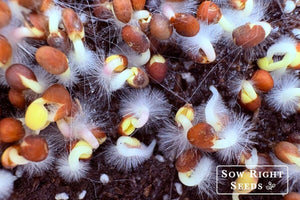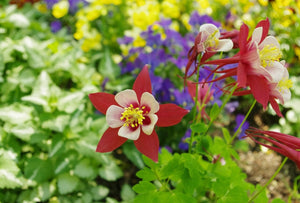How to Grow Luffa from Seed to Make Your Own Loofah Sponges
GourdsLoofah sponges come from luffa plants. These biodegradable, environmentally-friendly sponges are easy to grow from seed in your own backyard.

What Is a Loofah, Anyway?
Loofah is the same as luffa and is a plant in the gourd family. It’s easy to grow, and the gourds can be cooked like okra and eaten when young. However, here in the United States, it’s most commonly grown until full maturity to be used as loofahs or luffa sponges. The gourds are harvested, dried, and peeled to reveal the fibrous inner husk that we use to scrub.

If you’ve ever used a loofah, you know how luxurious these sponges can be. They’re absorbent, with just the right amount of exfoliating power to remove dead skin. They make good options for scrubbing dishes as well, making them a great replacement for scrub sponges or steel wool. They’re renewable and environmentally friendly because they come from a plant!
Luffa Gourd Seeds
Grow your own loofah sponges from heirloom luffa seeds. Luffa plants are easy to grow and don't cross-pollinate with other vegetables, so they can be added to any garden.
Starting Luffa/Loofah Plants from Seed
To grow luffa plants, you’ll want to consider the length of your growing season.
Luffa is a warm-weather plant, so if you have 150-200 frost-free days in a row, you can sow seeds directly outdoors once the temperature is high enough. If you live north of Zone 8, start luffa seeds indoors 6-8 weeks in advance in a seed starting mix to give them a good head start.
Use scarification or soak the seeds for 48 hours to improve germination rates. Keep your seeds warm and moist until they sprout, and provide plenty of light.
When night temperatures are above 55°F, harden off well-established luffa seedlings before transplanting them outside.
Luffa plants love moist, well-drained, rich soil. Find a sunny spot where they can grow, and provide them with 1-2 inches of water a week.

Tips for Luffa Seed Germination
- Scarify or soak luffa seeds for 48 hours before planting.
- Plant seeds 1 inch deep.
- Use a heat mat to keep the soil temperature between 70-85ºF.
- Keep soil moist until seeds sprout in 7-10 days.
- Once seeds have sprouted, keep grow lights close to prevent leggy seedlings.
- Water from the bottom to prevent damping off.

Growing Luffa Plants
Sun
Loofah plants are a warm-weather crop and need full sun to reach their full potential. The more sun, the better. At a minimum luffa plants need 6 hours of daily sunshine. In very hot climates, a little shade in the afternoon is okay.
Soil
Moist soil that is nutrient-rich will grow the best loofahs. Make sure the soil drains well so that the roots don't get water logged.

Watering
Consistent water of about 1 to 2 inches a week is needed for producing loofahs. The plants will be stressed if the soil is allowed to dry out. A layer of mulch can help conserve moisture and keep weeds out.
Fertilizing
Adding additional fertilizer throughout the growing season can result in more and bigger luffas. You can use a slow-release fertilizer applied every few weeks or a liquid fertilizer more frequently.

Pinching Luffa Plants
Gardeners often wonder if it's worth pinching or pruning their plants. It depends on what you are trying to accomplish. When growing luffa for sponges, you may want to pinch new growth later in the season so that the plant will focus its energy on the fruits already growing. One luffa plant in an optimal location can grow 5 to 20 fruits.
Pollination
Luffa plants are monoecious, which means they have male and female flowers. The female flowers need to be fertilized for fruit to set. This usually happens naturally by the visiting pollinating insects. But if it doesn't happen, the female flowers will fall off. You can hand pollinate if needed. Better yet, make sure you also add flowers to your garden to attract beneficial pollinators.

Support for Luffa Plants
It’s important to provide a trellis or some sort of support for luffa vines. They can grow over 30 feet during the growing season, so you’ll want to make sure you’ve got plenty of room for the vine to climb.
The hanging luffa gourds need to be able to drape down to grow straight. It’s much easier to peel and use a straight loofah than one that’s curved. These vines provide shade, and the visual appeal of the long-hanging fruit will be a striking addition to your garden.
You can grow your own all-natural, biodegradable luffa sponges.


Harvesting Loofah/Luffa Sponges
Luffa plants will start producing around 60 days after planting. However, if you want to make loofah sponges, they will need 100 to 200 days to mature. This is why you will want to start luffa seeds indoors in many growing zones.
One of the benefits of growing your own luffa sponge is that you can decide how soft or hard you want it to be. The softness of the loofah sponge will be determined by when you pick the luffa.
Luffas that are still green will be softer, but they also may not have matured enough to have a lot of fibers. These softer loofahs are more gentle on facial skin.
When luffas are completely brown, and the skin is dry, they are much more fibrous and will be harder. This is a great harvesting stage for a pot-scrubbing luffa sponge.
There's a sweet spot for harvesting luffa sponges when they are a nice brownish yellow. This stage is easy to peel and makes a nice semisoft loofah sponge.
Make sure to harvest your luffa before frost sets in. These plants are not frost-tolerant, and letting the fruit sit on the vine will cause them to rot in place. Instead, harvest them and dry them out before peeling them and revealing the loofahs within.
If you’re curious, yes, luffa sponge is also edible at the green stages while they are still small. They taste a bit like okra, and you can fry them. Most people grow them for loofahs, but there’s nothing wrong with eating some of your harvest, too.

How to Turn a Luffa Gourd into a Loofah Sponge
Once you've harvested your luffa gourd, it's time to prepare it for use as a loofah sponge.
To loosen the skin, step on the fruit and roll it under your shoe. Luffas that are still green will be juicy and can be more difficult to peel. If they haven't developed enough fibers, you won't have a usable loofah, so give the fruit time to develop before harvesting.
Once the luffa gourd is peeled, rinse it with water. The juicier it is, the more you will need to rinse and squeeze to get all the seeds and flesh off.
For completely dry luffa gourds, you can cut off the ends to shake out the seeds. It also helps to bang them on the side of a bucket to loosen the seeds.
You can harvest a lot of viable seeds for planting next season.
Allow the luffas to dry completely. Once they are dry you can cut them into usable sizes.

Extra Loofah Tips:
Luffa sponges can be used for scrubbing in the kitchen as well. They're environmentally friendly and can be added to your compost bin instead of the trash.
When cut into pieces, luffa sponges make a beautiful natural soap dish.
Unused loofah sponges can be stored indefinitely. Once dried, these natural scrubbers won't rot.
If you’ve got a sunny spot and some room for luffa to climb, you should try your hand at growing this unique plant. It’s fun and rewarding! Your vine should produce enough luffa gourds to provide you with plenty of gifts to share, too. You’ll feel great knowing you’ve grown a biodegradable alternative that does a better job than many of the other options out there.
Interested in learning more about growing luffa? Here are some suggested resources:
Commercial Luffa Sponge Gourd Production - NC State Extension
Written By Teresa Chandler & Beverly Laudie
Looking for more great gardening advice? Here are some suggested articles from our Planter's Library.
Popular Posts
-

Root Hairs or Mold? The Microgreen Mystery Solved!
-

15 Shade Loving Flowers for a Colorful Summer Garden







Leave a comment